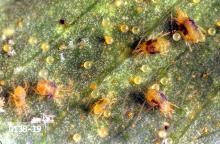Tetranychus urticae and other Tetranychus spp.
Pest description and crop damage These are a sporadic problem and generally more prevalent in Western Idaho. Spider mite outbreaks are associated with:
- Dusty sites; infestations especially begin along field edges adjoining dusty roads and in surface-irrigated fields.
- Excessive use of foliar-applied insecticides (especially pyrethroids [group 3A] and organophosphates [group 1B]) directed at aphid or pests other than spider mites, but which also kill mite natural enemies and so allow spider mites to increase without checks.
- Hot, dry weather that enhances mite survival and reproduction; short generation times and multiple generations allow explosive increases in spider mite infestation levels.
- Weedy fence rows and ditch banks where mites overwinter.
Scouting and thresholds No formal economic thresholds exist for spider mite insecticide treatment decisions.
Management-biological control
Spider mites are often held in check by predators, especially predatory mites. Predators can be favored by limiting use of foliar insecticides and growing sugar beets under overhead irrigation where possible to reduce dust on foliage.
Management-chemical control
A few conventional insecticides and miticides are available (Table 2), but efficacy may be limited by possible chemical resistance and explosive population growth. Many biorationale products are available (Table 3), but also face limitations in relation to spider mite population growth.


